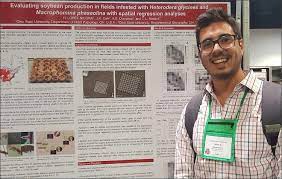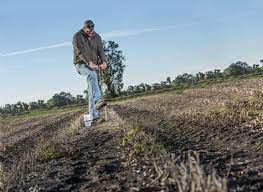Agronomy, Homepage Slider, Soybean Quality
SCN Testing in newly planted corn fields
By Dusty Sonnenberg, CCA, Ohio Field Leader, a project of the Ohio Soybean Council and soybean checkoff.
In an effort to better understand the dynamics of soybean cyst nematode (SCN), Dr. Horacio Lopez- Nicora, Assistant Professor, Soybean Pathology and Nematology, in the Department of Plant Pathology at The Ohio State University, College of Food, Agriculture and Environmental Sciences, is conducting research funded by the Ohio Soybean Council and soybean check-off. This research is evaluating SCN levels in both corn and soybean fields. “This is a research opportunity for growers to participate and help us understand the reproduction factors of SCN in Ohio,” said Lopez-Nicora.

The research requires farmers to collect soil samples from both corn and soybean fields at planting and again at harvest. “We want farmers to take a sample at planting, and it doesn’t matter if it is corn or soybeans,” said Lopez-Nicora. “Results from this first sample will be the initial population of SCN. Then at harvest we want the farmers to take another sample from the same area. This second sample will give us the final population of SCN. With the two pieces of information, we can calculate the SCN reproduction factor.”
The SCN reproduction factor is a number that will be important for a farmer’s management decisions moving forward. “With this number, we will know if the SCN increased, decreased or maintained its population density in that field,” said Lopez-Nicora. “Once determined, we will associate that factor with the crop that was planted in that field. For example, if we planted corn and we know that corn is a good crop to rotate with because it does not allow the SCN to reproduce, we will be able to know how much corn can reduce SCN in our fields. Similarly, if we plant soybeans variety and we observe a large increase in the SCN population at the end of the season, we will know that the specific cultivar was susceptible to that specific SCN population.”
Along with the crop in context, soil characteristics will be tracked. “We will also be able to relate this reproduction factor of the SCN population with soil variables,” said Lopez-Nicora. “Things like soil health, chemical and physical soil characteristics, texture, pH, organic matter, extractable nutrients and respiration will all help us better understand the SCN population dynamics.”
SCN samples should be collected the same as a regular soil sample. “Collect samples 8 inches deep, and mix several subsamples in a bucket from an area no larger than 10-20 acres,” said Lopez-Nicora. “These composite mixed samples should be submitted to Ohio State for analysis of both SCN and the other soil characteristics.”
To get the best information for the SCN factor, farmers should collect soil samples soon. “The idea is to try to capture the initial SCN population that the plant is exposed to, and then at the end of the season, the final population. The sooner the better for the initial population,” said Lopez-Nicora. “Once we determine if the SCN increase, decrease, or maintained population, and combine it with the crop planted and other soil variables, we will be able to better understand what we can do to reduce SCN numbers in our field.”
The SCN Coalition as well as the Ohio Soybean Council and soybean checkoff have provided a grant to process two free samples per farm. Farmers should download and complete this Soil Sample Submission Form and mail samples to:
OSU Soybean Pathology and Nematology Lab
Attn: Horacio Lopez-Nicora, Ph.D.
110 Kottman Hall
2021 Coffey Rd.
Columbus, Ohio 43210
With specific questions, you can also e-mail: lopez-nicora.1@osu.edu